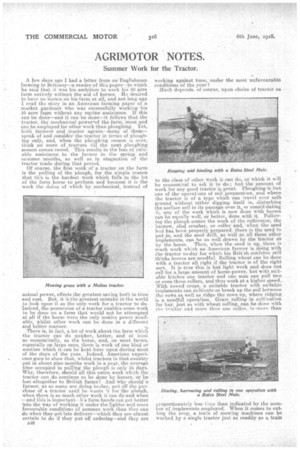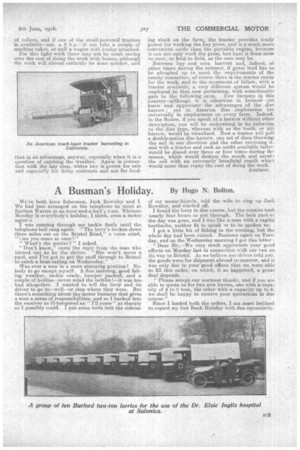AGRIMOTOR NOTES.
Page 18

Page 19

If you've noticed an error in this article please click here to report it so we can fix it.
Summer Work for the Tractor.
A few days ago I had a letter from-an Englishman farming in Brittany—a reader of this paper—in which _ he said that.it was his ambition to work his 80 acre. farm entirely without the -a-id of horSes. He desired. to have no horses on his farm at all, and not long:ago . I read the story in an American farthing paper of a market gardener who was successfully working his 10 acre farm without any equine assistance. If this can be done—arid it can be done—it follows that the tractor, the mechanical power'of the farm, .must arid can be employed for other work than ploughing. Yet, both farmers and tractor agents—many of them— speak of and consider the tractor in ternas of ploughing only, and, when the ploughing season is over, think no more of tractors till the next ploughing season comes-round. This results in the loss of valuable assistance, to the farmer in the spring and summer months, as well AS in stagnation of the tractor trade during that period,
Of -course, the first work of a tractor on the farm is the pulling of the plough, for the simple reason that this is the hardest work whioh falls to the lot of the farm horse to perform and because it. is the work the doiss: -of which by mechanical, instead of
animal power, effects the greatest saving both in time and cost. But, it is the greatest mistake in the world to look upon it as the only, work for a tractor to do. Indeed, the possession of a tractor enables some work to be done on a farm that would not be attempted at all if the horse were the. only motive power available; whilst other work can be done in a different and hater manner.
There is, in fact, a lot of work about the farm which the -tractor can do quicker, better, and at least as economically, as the horse, and, on most farms,
especially on large ones, i there s work of one kind or another which it can be kept busy upon during moSt of the days. of the year. Indeed, American experience goes to show that, whilst tractors in that country put in about nine months work in a year, the average time occupied in pulling the plough is only 55 days. Why, therefore, should all this extra work wh:ch the tractor -can do continue to be done by ,horses, or be lost altogether to British farms? Arid why should -afarmer, as so many are doing to-day, put off the purchase of a tractor until he wants it for the plough, when there is so much other work it can do and when —and this is impor tant—h's farm hands can get better into the way of working it under the lighter and more favourable conditions of summer work than they can do when they get late delivery—which they are almost certain to do if they put dff ordering—and they are
.1340
working against time, under the most unfavourable -conditions of the year ?
Much depends, of course, upon choice of tractor as
to the class of other work it can do, or which it will be economical to -ask it to do; but the amount ofwork for any good tractor is great. Ploughing is but one of the operations of soil preparation, and where the tractor is of a type which can travel over soft ground without either digging itself in, disturbing the surface soil in its passage over it, or conselldating it, any of the work which is now done with horses can be equally well, or better, done with it. Following the plough comes the work of the cultivator, the harrow, clod crusher, or -roller and, when the seed. bed has been properly, prepared, there is the seed to put in, and the seed drill, as well as all these other implements, can be as well drawn by the tractor ag by the horse. Then, When the seed is up, there is much work which an American farmer is doing with the tractor to-day for which his Brit'sh confrere still thinks horses are needful. Rolling wheat can be done with a tractor all right if the traCtor is of the right sort. It is true this is but light work and does not call for a large amount of horse-power, but with suitable hitches one tractor and one man can pull two or even three rollers, andthus-work at a higher speed.. With rowed crops, a suitable tractor with suitable implements can cultivate or break up the soil between the rows as well as ridge the rows up, where ridging is a needful operation. Grass rolling in etiltivatmn for hay, just'as with wheat rolling, can be done with the tractor and more then one roller. in More than proportionately less Cnie than indicated by the number of implements .employed. When it comes to cutting the crop-, a tram of mowing machines can be worked by a single tractor just as readily as a train"
of rollers, and if one of the small-powered" tractors is available—say, a 6 h.p.--it can take a couple of machine rakes, or pull a wagon with loader attached. For this light work there may not be much saving over the cost of doing the, work with horses, although the work will almost certainly he done quicker, and
that is an advantage, anyway, especially when it is a question of catching the weather. Again in connection with the hay crop, -where hay is grown for sale and especially for Army contracts and not for feed
ing stock on the farm, the tractor provides ready power" for working the hay press, and is a much more -convenient ontfit than the portable engine, because it can not 'only work the press, but haul it from mow to mow, or field to field, as the case may be. Between hay and corn harvest and, indeed, at other times during the summer, if grass land has to be ploughed up to meet the requirements of the county committee, of course there is the tractor ready for the work, and in the treatment of fallow, with a tractor available, a very different system would be employed 'to that now pertaining,with considerable gain to the following crop. Few farmers in this country—although it is otherwise in Ireland—yet know and appreciate the advantages of the disc harrow ; yet in America disc implements are universally in employment on every farm. Indeed, in the States, if you speak of a harrow without other description, you will be understood to be referring to the disc type, whereas with us the tooth, or pm lia,rrow, would be visualised. Now a tractor will pull a double-action disc harrow, one set of discs throwing the soil in one direction and the other reversing it, and with a tractor and such an outfit available fallow would be diseed over three or four times during the season, Which would destroy the weeds and aeratr) the soil with an extremely beneficial result which would more than repay the cost of doing the work. AGRIMOT.






















